
People have always admired the look of strong and toned arms. I don’t know about you, but when I see bodybuilders or powerlifters, chiseled arms are always a part that catches my eye.
Strong arms can take some time to build, but knowing why the exercises you are doing are valuable and knowing how to do them correctly can help you along the way. This is why we have developed this list that narrows down to some of the best exercises for a specific part of the biceps: the short head.
The biceps muscle[1] is made up of two heads, the short and long heads. The short head[2] lies more on the inside of the arm and helps give the whole muscle a more rounded shape. Both heads work to bend your arm at the elbow joint. By targeting these short head bicep exercises we’ve gathered, you can develop larger and more sculpted arms.
Best Exercise For Biceps Short Head
Building larger biceps doesn’t have to be complicated. Pick your favorite two to four of the short head bicep exercises below and try to increase the weight or the number of repetitions over time. If you add a few of these to your upper body routine, you should be able to notice growth in the biceps in a few weeks.
Best Short Head Bicep Exercises
Stronger muscles help make everyday life tasks easier, not to mention they look good! The biceps are a classic muscle to build and admire, so build the short head of your biceps with these targeted exercises.
As with all these short head bicep exercises, it’s important to get the correct weight. You can gauge if you’re using the correct weight by how many repetitions you can do. The goal is to be able to do three to four sets of six to twelve repetitions. If you can do more than twelve repetitions with the weight you chose, you can grab heavier weights and if you cannot get to six repetitions, the weight is too heavy.
Bicep Curl
These curls help to isolate and develop this specific area, leading to enhanced bicep peak and overall arm aesthetics. By incorporating this exercise, you can achieve better bicep definition and size while also improving upper body strength and functionality. Bicep Curls are a versatile and efficient way to sculpt your arms, making them an essential addition to your workout routine.
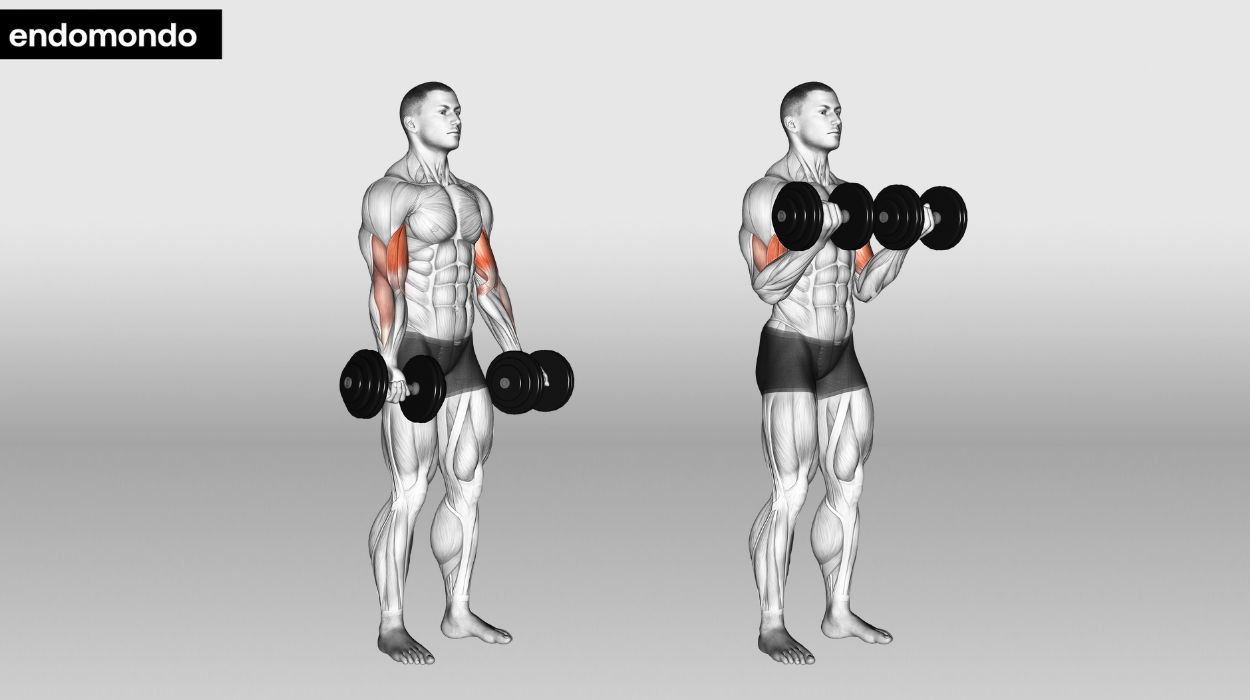
How to do:
- Begin by standing with your feet hip-width apart and holding a dumbbell in each hand at your sides, with your palms facing forward.
- Keep your back straight, chest up, and shoulders relaxed for proper posture.
- Slowly curl one dumbbell upwards by flexing your elbow, exhaling as you lift the weight towards your shoulder.
- Squeeze your biceps at the top of the movement, holding for a brief pause.
- Lower the dumbbell back down to the starting position in a controlled manner, inhaling as you extend your arm.
- Repeat the curl with the other arm for the desired number of repetitions while maintaining proper form and control.
- Engage your core throughout the exercise to provide stability and prevent swaying or arching of the back.
Tips:
- Keep your back straight, elbows close to your body, and wrists neutral throughout the movement. This ensures that you’re targeting the biceps effectively while minimizing the risk of injury.
- Avoid swinging or using momentum to lift the weight. Lift and lower the dumbbells or barbell slowly and under control to maximize muscle engagement and gains.
- Ensure you perform the full range of motion, from full extension to a complete contraction, to activate and work the short head of the bicep fully. This promotes muscle growth and definition.
Optimal Sets and Reps: 3 sets of 10-12 reps.
Dumbbell Concentration Curl
This isolation exercise hones in on the short head of the biceps, enhancing its peak and definition. By isolating the muscle, you maximize its engagement, leading to targeted growth and improved symmetry in your arms. Incorporating Concentration Curls into your routine can lead to more sculpted and aesthetically pleasing biceps.
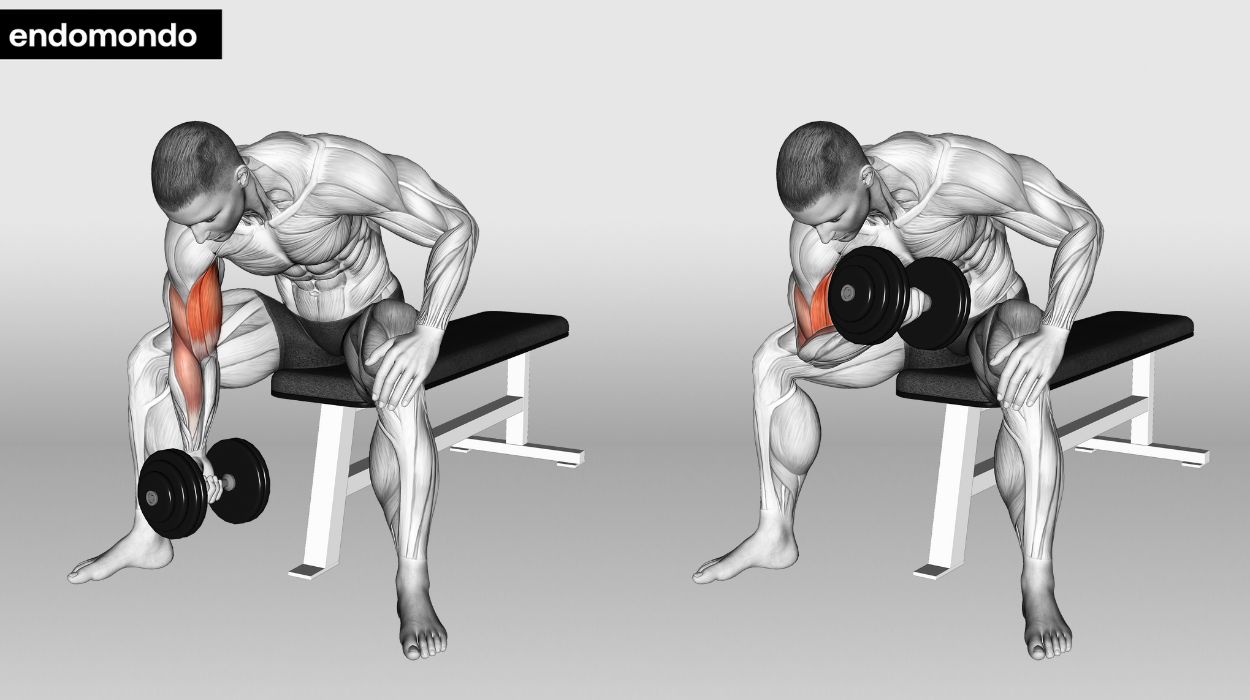
How to do:
- Sit on a bench or chair with your back straight, chest up, and feet flat on the floor.
- Hold a dumbbell in one hand and place your elbow against the inside of your thigh, with your arm fully extended and your palm facing forward.
- Slowly curl the dumbbell upwards by flexing your elbow, exhaling as you lift the weight toward your shoulder.
- Squeeze your biceps at the top of the movement and hold for a brief pause.
- Lower the dumbbell back down to the starting position in a controlled manner, inhaling as you extend your arm.
- Repeat the curl for the desired number of repetitions on one arm before switching to the other.
- Maintain proper form throughout, ensuring your back and head remain against the bench and your core is engaged for stability.
Tips:
- Sit with your elbow braced against your inner thigh, ensuring your upper arm remains stationary. This isolates the short head bicep for maximum engagement.
- Perform each curl through a complete range of motion, fully extending your arm on the way down and squeezing your bicep at the top of the movement for peak contraction.
- Emphasize controlled, deliberate movements to minimize swinging or momentum. This ensures that you’re targeting the short-head bicep effectively for optimal results.
Optimal Sets and Reps: 3 sets of 10-12 reps.
Dumbbell Preacher Curl
This exercise provides a unique angle, isolating the short head of the biceps, leading to targeted muscle growth and enhanced peak development. The preacher bench helps stabilize your upper arms, minimizing cheating, and maximizing bicep engagement.

How to do:
- Begin by setting up an incline bench at a slight angle, around 45 degrees, and place a dumbbell in front of it.
- Sit on the incline bench with your back against the pad, chest up, and feet flat on the floor.
- Hold a dumbbell in one hand with an underhand grip, ensuring your arm is fully extended and resting on the incline bench.
- Keep your upper arm against the bench as you curl the dumbbell upward, exhaling as you contract your biceps.
- Squeeze your biceps at the top of the movement and hold for a brief pause.
- Lower the dumbbell back down to the starting position in a controlled manner, inhaling as you extend your arm.
- Repeat the curl for the desired number of repetitions, then switch to the other arm.
- Maintain proper form throughout, keeping your back and head against the bench and your core engaged for stability.
Tips:
- Ensure your upper arms rest firmly against the preacher bench, maintaining strict form to isolate the short head of the biceps. Keep your back flat against the bench and avoid using momentum.
- Lift the dumbbell slowly while contracting your bicep fully, then lower it with control to maximize muscle engagement and minimize strain on the joint.
- Focus on feeling the short head of your biceps working throughout the exercise. Concentrate on the squeeze at the top of the movement to enhance muscle activation and results.
Optimal Sets and Reps: 3 sets of 10-12 reps.
EZ Bar Preacher Curl
By utilizing this exercise, you emphasize the short head of the biceps while maintaining proper form and minimizing cheating. This targeted approach helps create peak and definition in your biceps, leading to well-rounded arm development.
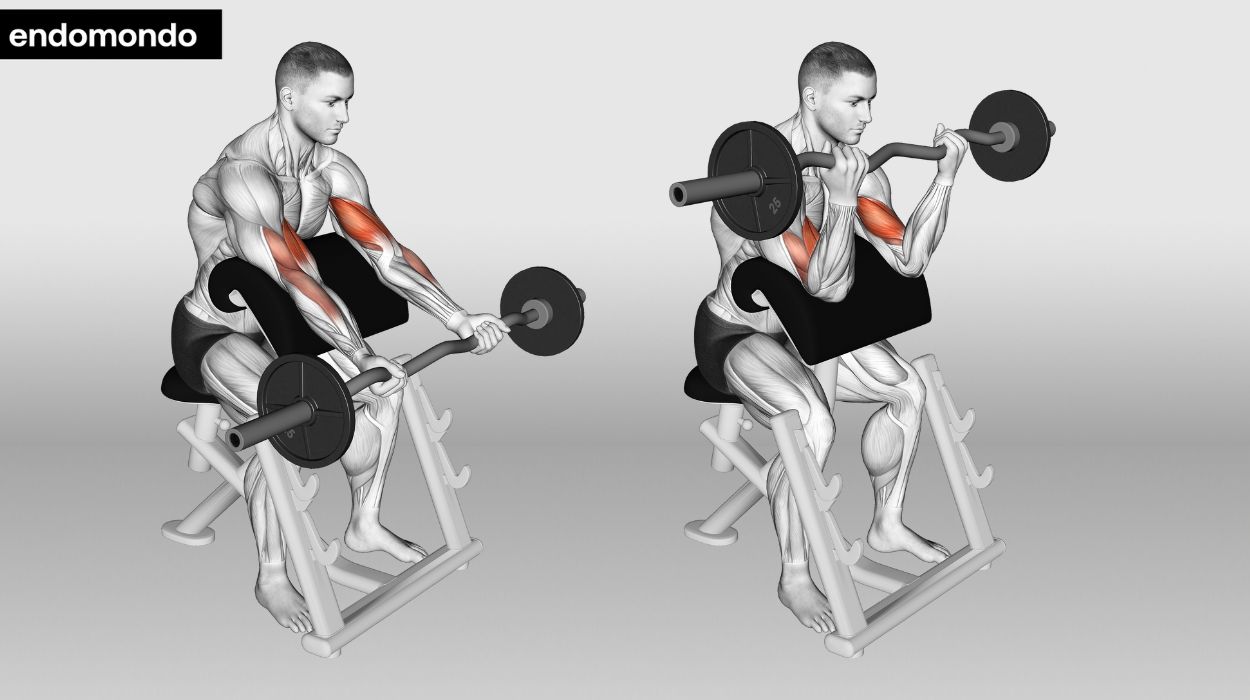
How to do:
- Begin by setting up an EZ bar on a preacher bench, making sure the bar is loaded with the desired weight.
- Sit on the preacher bench with your chest against the pad and your feet flat on the floor.
- Grasp the EZ bar with an underhand grip (palms facing up), ensuring your hands are shoulder-width apart.
- Rest your upper arms on the angled pad of the preacher bench, with your elbows fully extended and your armpits against the top of the pad.
- Slowly curl the bar upwards by flexing your elbows, exhaling as you lift the bar toward your shoulders.
- Squeeze your biceps at the top of the movement and hold for a brief pause.
- Lower the EZ bar back down to the starting position in a controlled manner, inhaling as you extend your arms.
- Repeat the curl for the desired number of repetitions, maintaining proper form and control.
- Engage your core and keep your back against the bench for stability throughout the exercise.
Tips:
- Ensure your elbows are firmly positioned on the preacher bench pad throughout the exercise. This stabilizes your upper arms, isolates the short head of the biceps, and minimizes cheating.
- Maintain a slow and controlled lifting and lowering motion. Avoid swinging or using momentum to lift the bar, as this ensures maximum muscle engagement and minimizes the risk of injury.
- Lower the barbell fully to stretch the biceps, then curl it upward until your forearms touch your biceps. This complete range of motion optimizes muscle activation and helps achieve the best results in your short head bicep workout.
Optimal Sets and Reps: 3 sets of 10-12 reps.
Hammer Curl
Unlike traditional curls, Hammer Curls engage both the short and long head of the biceps, promoting balanced and well-rounded arm development. This exercise also targets the brachialis, a muscle beneath the biceps, further enhancing arm thickness and strength. Incorporating Hammer Curls helps prevent muscle imbalances and creates a more aesthetic and functional upper arm.

How to do:
- Begin by standing with your feet hip-width apart and holding a dumbbell in each hand at your sides, with your palms facing your torso.
- Keep your back straight, chest up, and shoulders relaxed for proper posture.
- With your palms still facing in, slowly curl both dumbbells upwards by flexing your elbows, exhaling as you lift the weights toward your shoulders.
- Squeeze your biceps at the top of the movement, holding for a brief pause.
- Lower the dumbbells back down to the starting position in a controlled manner, inhaling as you extend your arms.
- Repeat the curl for the desired number of repetitions while maintaining proper form and control.
- Engage your core throughout the exercise to provide stability and prevent swaying or arching of the back.
Tips:
- Hold the dumbbells with a neutral (palms facing each other) grip throughout the exercise. This emphasizes the short head of the biceps and the brachialis for a well-rounded bicep workout.
- Lift and lower the weights in a slow and controlled manner to maximize time under tension, which is crucial for muscle growth in the short head of the biceps.
- Keep your upper arms stationary and avoid using momentum to lift the dumbbells. This ensures that you’re isolating the biceps and brachialis effectively for the best results.
Optimal Sets and Reps: 3 sets of 10-12 reps.
Wide Grip Barbell Curl
By using a wider grip on the barbell, you emphasize the short head of the biceps, promoting enhanced muscle development in this specific area. This exercise helps create a fuller and more defined bicep peak, contributing to an aesthetically pleasing look. Including Wide Grip Barbell Curls in your routine can lead to improved overall bicep strength and aesthetics while targeting the short head for a well-balanced and sculpted upper arm.
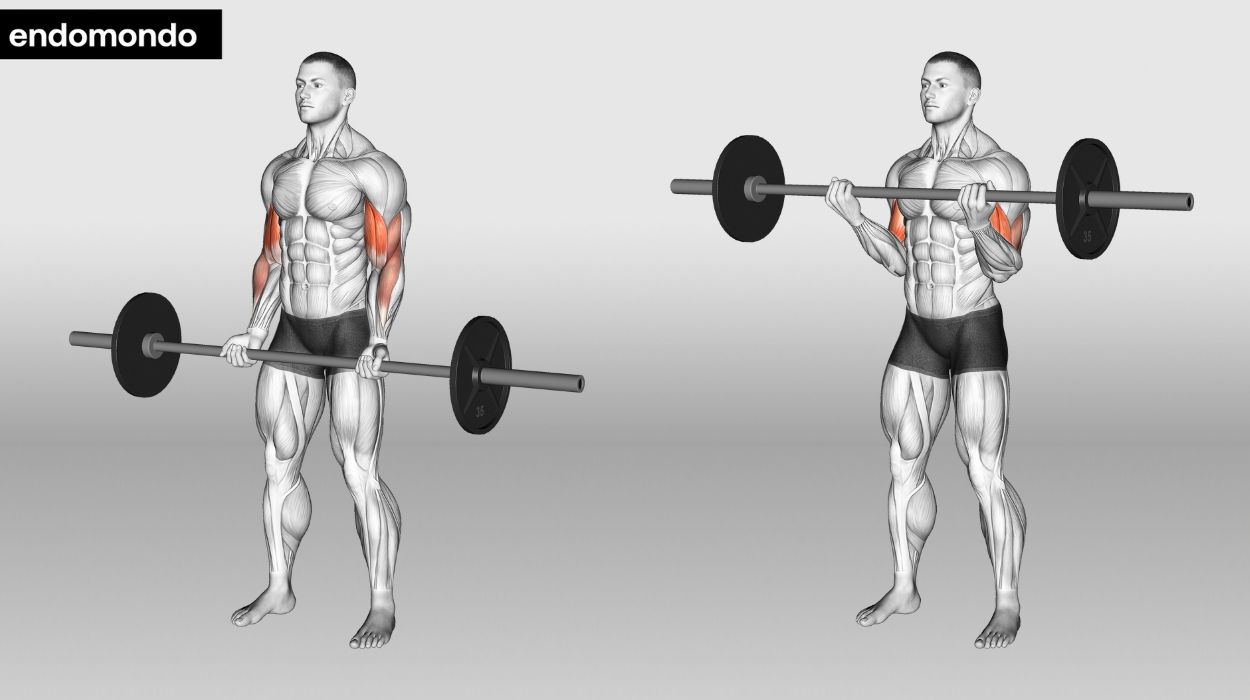
How to do:
- Begin by standing with your feet shoulder-width apart and holding a barbell with a wide overhand grip, palms facing forward.
- Keep your back straight, chest up, and shoulders relaxed for proper posture.
- Allow the barbell to hang at arm’s length in front of your thighs, with your hands wider than shoulder-width apart.
- Slowly curl the barbell upwards by flexing your elbows, exhaling as you lift the bar towards your shoulders.
- Squeeze your biceps at the top of the movement and hold for a brief pause.
- Lower the barbell back down to the starting position in a controlled manner, inhaling as you extend your arms.
- Repeat the curl for the desired number of repetitions while maintaining proper form and control.
- Engage your core throughout the exercise to provide stability and prevent swaying or arching of the back.
Tips:
- Widen your grip on the barbell to target the short head of the biceps effectively. Keep your hands slightly wider than shoulder-width apart to maximize the engagement.
- Stand tall with your chest up, shoulders back, and elbows close to your sides. This not only targets the short-head biceps but also prevents cheating through body momentum.
- Lift the barbell with a slow and controlled motion, emphasizing the squeeze at the top to fully engage the short-head bicep. Lower the weight under control to maximize the exercise’s benefits.
Optimal Sets and Reps: 3 sets of 10-12 reps.
Spider Curl
By performing this exercise on an incline bench, you isolate the biceps and reduce reliance on other muscle groups. Spider Curls help build a well-rounded and defined short-head bicep, enhancing the appearance of your arms.
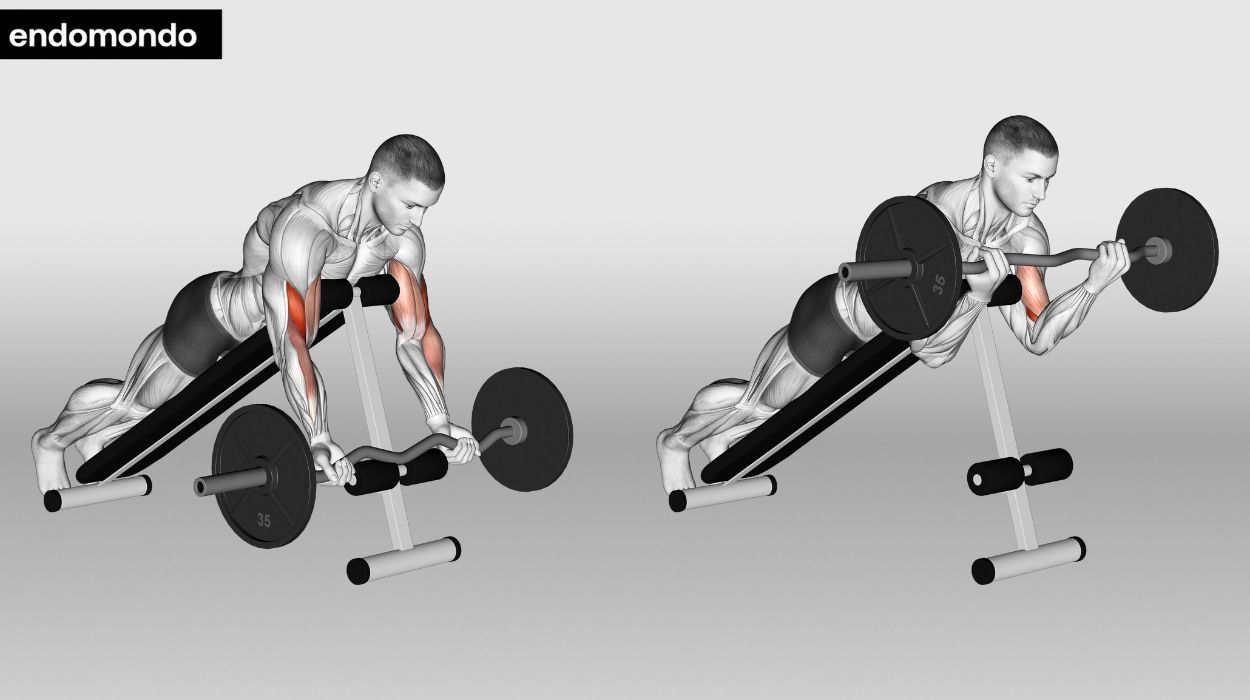
How to do:
- Begin by setting up an incline bench at around a 45-degree angle and place a barbell in front of the bench.
- Lie face down on the incline bench with your chest and upper body against the pad, ensuring your shoulders are at the top of the bench and your feet are on the floor.
- Reach forward and grasp the barbell or an EZ bar with an underhand grip (palms facing up), hands shoulder-width apart.
- Allow the barbell to hang at arm’s length in front of the bench, with your arms fully extended.
- Slowly curl the barbell upwards by flexing your elbows, exhaling as you lift the bar towards your forehead or the top of your forehead.
- Squeeze your biceps at the top of the movement and hold for a brief pause.
- Lower the barbell back down to the starting position in a controlled manner, inhaling as you extend your arms.
- Repeat the curl for the desired number of repetitions while maintaining proper form and control.
- Engage your core and keep your chest against the bench for stability throughout the exercise.
Tips:
- Use an incline bench set at a 45-degree angle, allowing your arms to hang freely. Keep your chest against the bench for stability and to isolate the short head of your biceps.
- Focus on controlled and deliberate curls, ensuring a full range of motion. Squeeze your biceps at the top of each rep to maximize muscle engagement.
- Keep your elbows in front of your body throughout the exercise to emphasize the short head of the biceps. Avoid swinging or using momentum to lift the weight, maintaining strict form for optimal results.
Optimal Sets and Reps: 3 sets of 10-12 reps.
Chin-Ups
This compound exercise also engages the back and core muscles, providing a well-rounded upper-body workout. Chin-ups improve overall upper body strength, enhance grip strength, and contribute to a sculpted and powerful short-head bicep.

How to do:
- Find a sturdy horizontal bar, such as a pull-up bar, and ensure it can support your body weight.
- Stand facing the bar with your feet together and your palms facing you (underhand grip).
- Reach up and grasp the bar with your hands shoulder-width apart or slightly narrower.
- Hang from the bar with your arms fully extended and your shoulders relaxed.
- Engage your core and pull your shoulder blades down and back to prepare for the movement.
- Begin the exercise by pulling your body upward toward the bar, exhaling as you do so.
- Focus on using your back and arm muscles to lift your body until your chin is above the bar.
- Squeeze your back muscles at the top of the movement and hold for a brief pause.
- Lower your body back down in a controlled manner, inhaling as you extend your arms.
- Repeat the chin-up for the desired number of repetitions while maintaining proper form and control.
- Engage your core throughout the exercise to stabilize your body and prevent swinging.
Tips:
- Use an underhand, supinated grip with your palms facing you. This grip targets the biceps more effectively than a traditional pull-up grip.
- Ensure you perform each Chin-Up with a complete range of motion, starting from a dead hang and pulling yourself up until your chin clears the bar. This maximizes bicep activation.
- Maintain a tight core throughout the exercise to support your body and prevent swinging. Controlled, deliberate movements lead to better results and injury prevention.
Optimal Sets and Reps: 3 sets of 10-12 reps.
Upright Row
This exercise indirectly engages the short head of the biceps, providing a well-rounded arm workout. Including Upright Rows can improve overall upper body strength and shoulder stability while helping sculpt the biceps for a more balanced arm appearance.
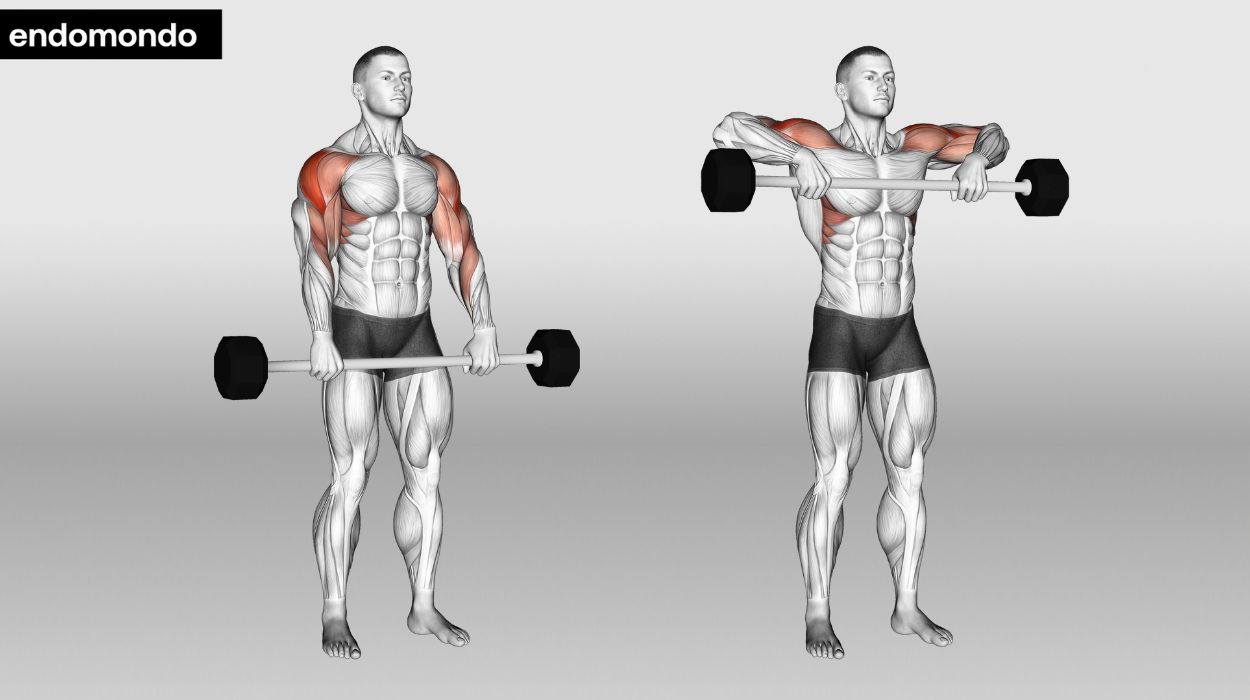
How to do:
- Begin by standing with your feet shoulder-width apart and holding a barbell or dumbbell in front of your thighs, with an overhand grip (palms facing your body).
- Keep your back straight, chest up, and shoulders relaxed for proper posture.
- Allow the weights to hang at arm’s length in front of your thighs.
- Slowly lift the weights upward by pulling them towards your chin while keeping them close to your body, exhaling as you raise them.
- Keep your elbows pointed out to the sides as you lift the weights.
- Lift the weights until they are just below your chin or upper chest.
- Hold the position for a brief pause, squeezing your shoulder and upper back muscles.
- Lower the weights back down to the starting position in a controlled manner, inhaling as you lower your arms.
- Repeat the upright row for the desired number of repetitions while maintaining proper form and control.
- Engage your core throughout the exercise to provide stability and prevent swaying or arching of the back.
Tips:
- Use a grip slightly wider than shoulder-width to minimize stress on the shoulder joints. Keep your wrists straight to prevent potential strain.
- Maintain a neutral or slightly forward elbow position, avoiding excessive elevation to prevent shoulder impingement. Lift the weights by leading with your elbows rather than your wrists.
- Lift the weights smoothly with controlled motion, keeping them close to your body throughout. Lower them back down slowly to maximize muscle engagement and minimize the risk of injury.
Optimal Sets and Reps: 3 sets of 10-12 reps.
Best Bicep Short Head Workout Routine
| Exercise | Sets x Reps |
| Bicep Curl | 3 x 10-12 reps |
| Dumbbell Concentration Curl | 3 x 10-12 reps |
| Dumbbell Preacher Curl | 3 x 10-12 reps |
| EZ Bar Preacher Curl | 3 x 10-12 reps |
| Hammer Curl | 3 x 10-12 reps |
| Wide Grip Barbell Curl | 3 x 10-12 reps |
| Spider Curl | 3 x 10-12 reps |
| Chin-Up | 3 x 10-12 reps |
| Upright Row | 3 x 10-15 reps |
Benefits Of Biceps Short Head Exercises
Why focus on the short head of the bicep? Here are just a few benefits of isolating this muscle while doing short head bicep exercises.
- Muscle growth: The short and long heads of the biceps run parallel to each other. The short head is on the inside and training it specifically will help develop bigger biceps.
- Strength: By training each head individually, you can develop greater overall strength.
- Helps with other lifts: The biceps is a muscle group that assists with pulling motions and by strengthening it in isolation, you will see improvements with compound exercises such as pull-ups or rows.
- Burn fat: Exercise has been shown to help with weight loss. Studies have shown that resistance training plus aerobic training[3] can reduce body fat and improve muscle tone.
Tips For Doing Short-Head Biceps Exercises
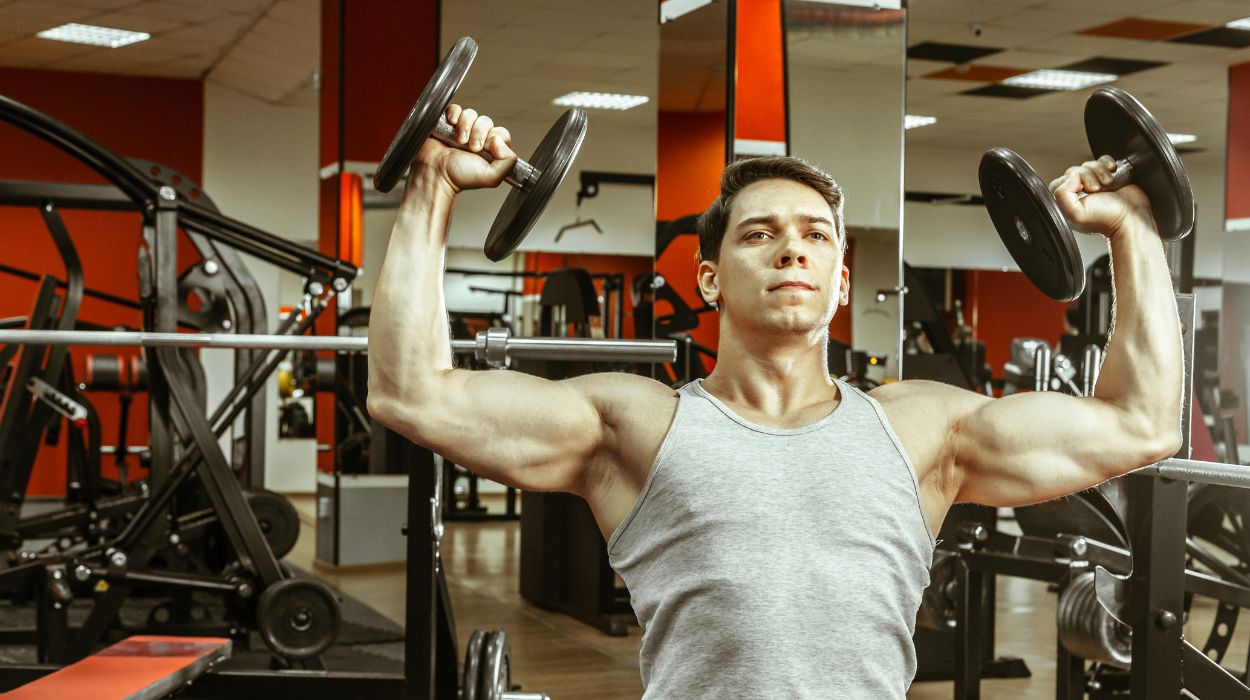
Make sure you’re getting the most out of your short-head bicep exercises! Getting to the gym is part of the journey, so optimizing your time there will help you see results faster. Keep the following things in mind when implementing or continuing an exercise routine.
- Focus: By concentrating on[4] muscle activation, you can see greater hypertrophy gains versus just going through the motions.
- Have a purpose: Whether your goal is to lose body fat, increase muscle size, or for mental health purposes, knowing why you’re going to the gym will help keep you motivated to reach those goals.
- Track progress: By writing down how much you are lifting during each gym session, you can track volume increases.
Conclusion
There are many ways to develop the short head of the bicep. In doing so, you will create more shapely upper arms and see improvements in other lifts. Make sure that you go into short head bicep exercises with determination to get the best short head bicep workout you can!
Frequently Asked Questions
An EZ bar is one bar that you hold in both hands so both arms are working together to move one weight. With dumbbells, you hold separate weights so each arm is working individually.
Only slightly. The short head has a closer attachment point than the long head. The muscle bellies themselves are about the same size, it is only the tendons that differ in length.
Aim to do one or two short-head bicep exercises, and one to two long-head bicep exercises per workout for optimum muscle growth.
The form is crucial to building muscle. Most of the time personal trainers will be happy to do a quick form check if you ask them, or if it is within your financial means, you can hire them for a few sessions for ultimate certainty.
Resources
- Tiwana, M.S., Charlick, M. and Varacallo, M. (2023). Anatomy, Shoulder and Upper Limb, Biceps Muscle. [online] Nih.gov. Available at: https://www.ncbi.nlm.nih.gov/books/NBK519538/.
- Crichton, J.C.I. and Funk, L. (2009). The anatomy of the short head of biceps – not a tendon. International Journal of Shoulder Surgery, [online] 3(4), pp.75–75. doi:https://doi.org/10.4103/0973-6042.63209.
- Munhoz, R., Moreira, C.E., Silva, Landi, D.C., Flávia Campos Corgosinho, Pelissari, A.C., Sofia, Tock, L., Tufik, S., Marco and Dâmaso, A.R. (2020). The effect of aerobic plus resistance training associated with a long-term interdisciplinary weight loss program on visceral fat and isokinetic parameters in adolescents with obesity. Journal of Sports Medicine and Physical Fitness, [online] 60(6). doi:https://doi.org/10.23736/s0022-4707.19.09857-8.
- Brad Jon Schoenfeld, Vigotsky, A., Contreras, B., Golden, S., Alto, A., Larson, R., Winkelman, N. and Paoli, A. (2018). Differential effects of attentional focus strategies during long-term resistance training. European Journal of Sport Science, [online] 18(5), pp.705–712. doi:https://doi.org/10.1080/17461391.2018.1447020.




